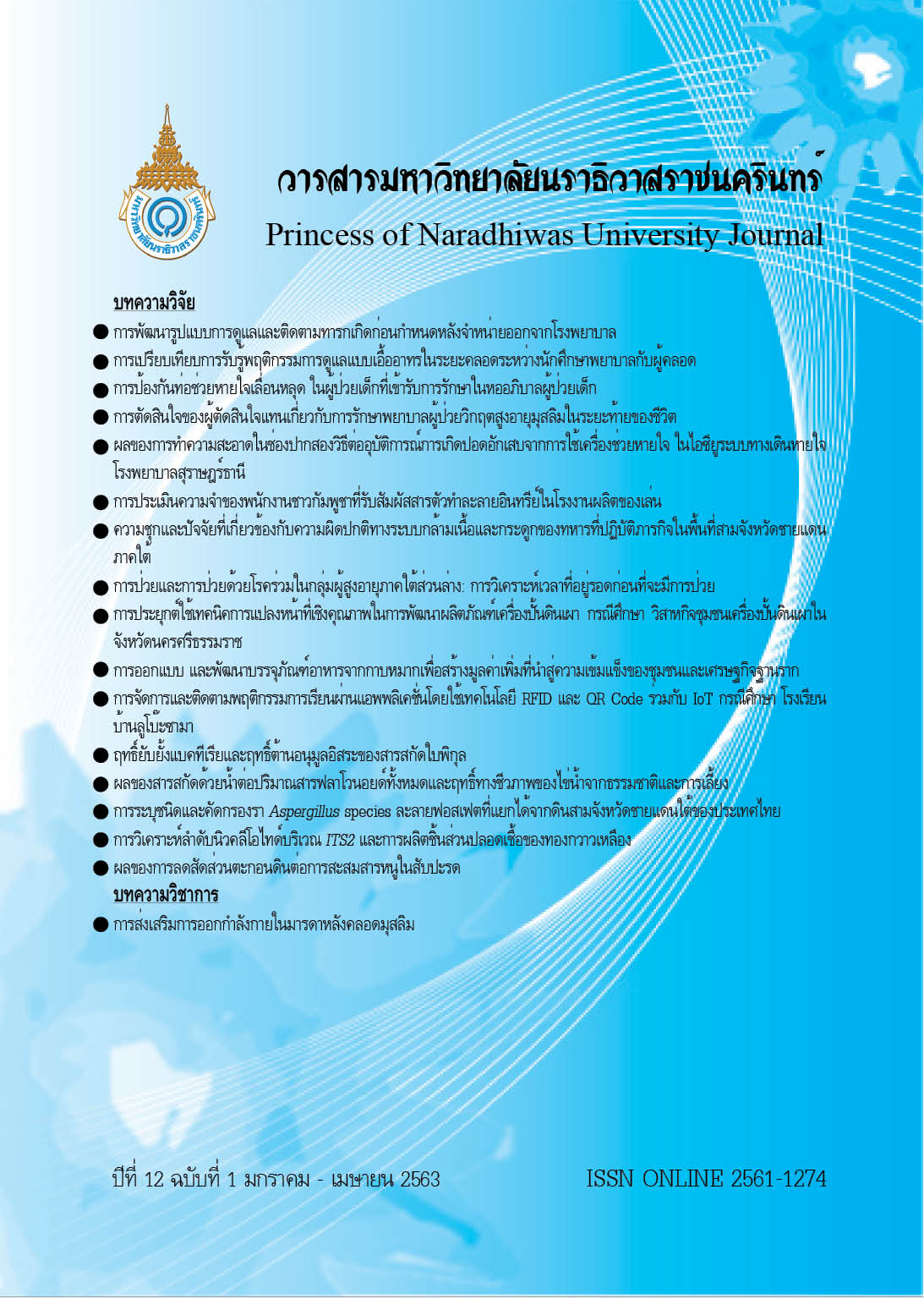Premature Infants: A Care and Post-Discharge Follow-Up Model
Keywords:
Premature Infants, Care and Follow-up Model, Newborn Home Health Care, Post-DischargeAbstract
The objective of this participatory action research was to develop a care and follow-up model for premature infants after discharge from hospitals. Purposive sampling was used to form 2 groups: a sample group to develop the care and follow-up model for premature infants after discharge from hospitals had 20 participants. And the sample group of 15 participants received the care and post-discharge follow-up model
for premature infant, which were divided into three phases: preparation, implementation and evaluation.
Qualitative data were collected by means of interviews, observation, focus group discussion, and writing
field notes. Data were analyzed by using content analysis for the qualitative approach. Descriptive statistics
were used for demographic information and the participants’ satisfaction of the model.
The results revealed that this model offered: 1) a structural model for several stakeholders to continue giving care from hospitals in NICU until discharged home and infant’s age of 12 months (Newborn Home Health care: NHHC), 2) a transitional record form for discharge planning of the premature infants (NHHC-1), 3) a transitional record form for follow-up mothers and their premature infant after birth (NHHC- 2), and 4) a complimentary manual of care for premature infants after discharge from hospital. Satisfaction towards the research procedures among the group of participants in the model development was at a high level (M = 3.38, SD=0.33 และ M = 3.63, SD=0.23, respectively). These findings indicate that this care and post- discharge follow-up model for premature infants could lead to reach achievement in better quality of care for premature infants
References
Bureau of Polity and Strategy. (2013). Public health statistics. [Database on the Internet]. Retrieved Jan 26, from http://bps.ops.moph.go.th/
Chompoolong, S., & Sriruksa, S. (2013). The development nursing service system of preterm infant in mahasarakham hospital and network. Journal of Nurses’ Association of Thailand, North-eastern Division, 31(2), 151-164.
Crane, P., & O’Regan, M. (2010). On PAR using participatory action research to improve early intervention.
Department of Families, Housing, Community Services and Indigenous Affairs, Australian Government.
Hayeese, W., Sap-In, N., Wangsawat, T., & Chaimongkol, N. (2015a) Quality of life of Muslim preterm infant in three southernmost provinces of thailand. Princess of Naradhiwas University Journal, 7(1), 1-14.
Hayeese, W., Sap-In, N., Wangsawat, T., & Chaimongkol, N. (2015b). Influencing factors of quality of life of muslim preterm infants in the three southernmost provinces. The Journal of Faculty of Nursing, Burapha University, 23(3), 26-40.
Hayeese, W., Sap-In, N., Pichaisongkram, S., & Chaimongkol, N. (2016). Effects of the perceived self-efficacy promotion program of caregivers on quality of life of muslim preterm infants in Narathiwat province. The Journal of Faculty of Nursing, Burapha University, 24(2), 51-60.
Kaoloung, K., Rutchanagul, P., & Pookboonmee, R. (2012). Develop a discharge planning model to promote continuity care for pre-term infants. Journal of Health Science Research, 6(1), 27-39.
Kuaniewicz, M, W., Parker, S, J., & Schnake, M, A. (2013). Hospital readmission and emergency department visits in moderate-preterm: Late preterm and early term infants. Clin. Perinatol, 40, 753-775.
Mally, P, V., Bailey, S., & Hendrisks-Munoz, K, D. (2010). Clinical issue in the management of late preterm infants, Curr. Probl. Pediatr. Adolesc. Health Care, 40, 218-233.
Ministry of Public Health. (2017). Public health statistics, A.D. 2016. Bangkok: Strategy and Planning Division. (in Thai).
Peesara, N., Payakkaraung, S., Thampanichawat, W., & Rungamornrat, S. (2017). Effect of an education program about environmental management for developmental care of preterm infants on nurses’ knowledge and practice in neonatal intensive care unit. Journal of Nursing Science, 35(2), 4-14.
Sangtawesin, V., Singarj, Y., & Kanjanapunkul, W. (2011). Growth and developmental outcome of very low birth weight infants at 18-24 months of age. Journal of Medical Association of Thailand, 94(3), 101-106.
Sein, U, T. (2006). Health Volunteers: Third workforce for health-for-all movement. Regional Health Forum,
(1), 38-48.
Stringer, E, T. (2007). Action Research (3rd ed.). Los Angeles: Sage.
Vohr, B. (2013). Long-term outcome of moderately preterm: Late preterm and early term infants. Clin.Perinatol, 40, 739-751.




